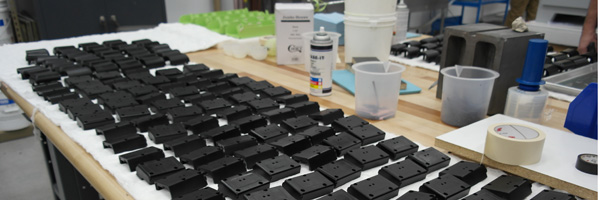
Trends in Additive Manufacturing for 2016
Additive manufacturing will continue to advance this year. Expect larger production runs, increased complexity of parts, greater strength, new materials and more.
Here’s a rundown of the trends to look for in 2016:
Beyond prototyping
With standardization in place, additive manufacturing (AM) will be used to create a wide range of finished goods. High-volume production runs soon will be common. These mass-produced parts will be delivered within tight specifications for cars, planes, healthcare and beyond.
More outsourcing
In recent years, many designers and engineers have used their own consumer-grade 3D printers. These printers were brought into offices to deliver rapid prototyping, but have led to problems and headaches instead. High error rates, long print queues and aging machines will lead many companies to outsource all of their additive manufacturing and 3D printing to specialists in 2016.
A higher quality of outsourcing
As more work moves to specialists, expectations of quality and customer service will rise accordingly. So far, specialists have been up to the challenge. The trend of quality seen in the end of 2015 will continue through 2016, with more consistent production, higher security (both digital and physical), more traceable materials and more personalized customer service.
A growing list of industries
The reliable production of standardized, certified parts will take additive manufacturing into new industries. Expect to see applications in consumer goods, electronics, telecom, utilities, computing, and construction.
Greater sophistication of lightweight parts and components
According the Defence iQ survey mentioned above, 69% of industry experts name “lightweight properties” as the chief benefit of AM. Research and development in 2016 will aim to add strength and complexity to these lightweight parts.
Strength will come from materials such as advanced engineering polymers, metals and hybrid polymer-metals. Complexity will come from new AM techniques, such as lattice structures, cavities, and creation of seamless, interconnected sub-assemblies.
Additive manufacturing with ceramics
New processes are being developed for manufacturing with ceramic materials. Research published within the last year discusses new methods such as “slurry-based additive manufacturing” as well as hybrid AM methods for metal-ceramic composites. These new methods are expected to create many new uses—and markets—for ceramic parts.
Building with biomaterials
Researchers will continue to develop new ways to work with biomaterials. Advances will be pursued in prostheses, medical devices, surgical models, custom implants, tissue engineering, tissue printing and regenerative medicine.
Expanding the scale of operations will also lead to innovation. Very small items—microstructures and nanostructures—will open new medical frontiers, as will large manufacturing capacities. Large-scale AM will lead to a greater number of patients served and more ambitious applications of biomaterials.
Color is here
Customers of AM continue to ask for brighter, more vibrant and more detailed colors. Color in industrial applications can help reduce errors, speed up assembly times, improve workplace safety, differentiate products and create more effective training tools. Today’s leaders in color technology are capable of more than 10 million colors, with ink drop placement in 32 micron layers. Expect to see more fine details, text and thin lines on AM parts in 2016.
Stereolithography will grow
Stereolithography (SLA) is a method of additive manufacturing that uses layering, invented over 30 years ago. Gartner’s Pete Basiliere expects SLA to show strong growth over the next few years, delivering a compound annual growth rate of 85.5% between 2015 and 2019.
More research and development
Research and development in AM will grow for two primary reasons. First, AM companies will pursue innovation in order to stay ahead of competitors. Second, traditional manufacturers will increase investments in AM as they decide whether or not they want to bring AM in-house, and if so, to what degree. Manufacturers who are already experienced with AM will continue to push for higher performance.
Parts for making parts
AM isn’t just for making parts—a third of industry experts polled by Defence iQ expect AM to “revolutionize the mainstream production of components and parts”. It’s likely that AM will soon become a common way to create tooling for mass-produced parts. AM will also be used for on-site repairs and replacements in factory settings. This approach may even eliminate the need to maintain an inventory of spare parts.
Standards, certifications and quality assurance
In a recent survey conducted by Defence iQ, more than 75% of industry experts said additive manufacturing’s biggest challenge is certification of finished parts and products. In 2016, industry associations will work toward certifications, standards and quality assurance procedures. Once the industry self-regulates and sets the bar for quality, mass production through additive manufacturing will follow.
Talk to us for advanced additive manufacturing
We’ll be pushing the industry forward in 2016, just as we’ve done for more than 20 years. Send us a question or request a detailed quote for your next project. Our experienced engineers will help you decide on the best additive manufacturing tools and techniques for the job.
If you don’t have a project on hand, that’s fine too. We’re happy to answer questions and talk about new techniques that might benefit your work.
